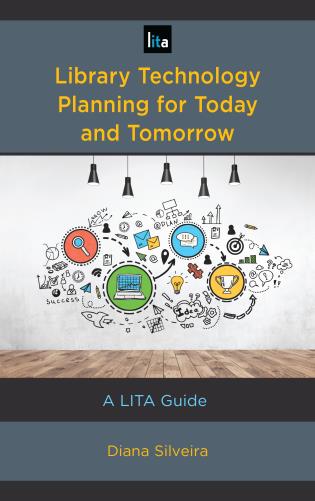 An interview with the author, Diana Silveira.
An interview with the author, Diana Silveira.
You’re a consultant with your own company, Novare Library Services. How did you get there?
I started out working for the Charlotte Mecklenburg Library, a large public library system in North Carolina then, after a few years, I moved to Florida where I worked for a multi-type library cooperative, Tampa Bay Library Consortium, which runs several statewide and regional programs. I still do training through the Florida multi-type library cooperatives and bring in speakers from other library systems throughout the country to present webinars for Florida Library Webinars. While working for Tampa Bay Library Consortium, I recognized that there was a real need within local public libraries for someone to come alongside and help with technology planning. Now, through my own company, I support libraries with technology training, planning, and web design. There are many rural libraries without technology resources in Florida, and it’s my passion to help them. I had heard horror stories about public library websites: the site built by a high-school student who has since disappeared; the site built several years ago by a third-party development company that the library can no longer update, and I found I could help them.
Where do you go to get ideas for cutting-edge technology? What are your sources of inspiration? People? Websites? Reports?
Ideas are everywhere. I read every night and just get caught up in new trends. Sources I go to include:
- mainstream news sites like Mashable, Fast Company, and Wired
- Conferences and associations like ALA, FLA, LITA, ATD, and CES
- Podcasts like Library Pro and general technology interests
- The annual Horizon Report
- Following and talking with influencers on Facebook and in-person
- Just talking with other librarians and participating in events like MakerFest and Makerpalooza which are regional conference events in Florida.
- Flipboard – Technology Channel
I like to read about the absolute cutting edge and also practical applications technology. What can we do now with technologies in libraries, what will we be able to do in a year or five years. The news you read with technology doesn’t always need to be library related; it’s vital to see what is beyond our doors and see how it can be utilized in our lives and within the library.
You talk about the importance of staying up to date with technology outside of the library context, saying, “It’s vital to see what is beyond our doors and see how it can be utilized in our lives and within the library.” As we plan and implement technology within libraries, how do we balance the drive for shiny new technology with technology that meets a clear purpose, is useful and is used?
Having clear and written goals, tied explicitly to your library’s mission statement, can help with this. I talk about this in the book: “These goals and outcomes will relate directly to the new technologies you plan to bring to your library. By tying technology to specific goals, everyone – staff, community, and stakeholders, can understand which community needs the technologies will fulfill” (p. 44). If a shiny new technology can’t be tied to any goals in your technology plan, or your library’s mission statement, how will implementing that technology propel the library forward?
Your book discusses at length the need to spend time collecting community input that will inform the technology plan, as well as the importance of seeking feedback from library staff. How do you avoid being taken hostage by others’ bad ideas? (Ex. A staff member vigorously champions specific hardware/software with a niche focus that you know will be underutilized in your community.)
I think it is essential to have a committee and also an ultimate decision maker. One key thing is to balance the voices. Just because one voice is loud, it is not any more important than the others. By reaching out to different groups, an individual voice isn’t as powerful.
For example, you might have someone who is pulling for that one technology. However, if the community assessment and general surveys from ALL staff don’t have the same technology floating to the top, you can use that as leverage to help make it less personal and more focused on the larger picture.
Please tell us about your biggest technology implementation/planning win?
One, helping a library build one of the first makerspaces in Pinellas County. It is integrated throughout the library and brings together art and technology. One thing I liked about this implementation, we did switch gears some after engaging the community. The community wanted the art aspect, and we responded. Another win was helping a library convince the larger IT structure that upgrades were needed. They were working with Windows 7 and Internet Explorer. I worked with the library director to present the facts and helped them get upgraded equipment.
What does a makerspace with an “art aspect” look like?
Good question! We added an art studio, a very flexible space that included all kinds of painting supplies as well as lots of beads for beadwork.
What do you do with failure? How do you bounce back when a planned investment in new technology doesn’t turn out as you hoped it would? What do you say to your director/board/funders?
Failure is going to happen. However, planning can help minimize failure. Planning needs to include not just the implementation but the marketing and training. Training both staff and users is an ongoing process. Technology often fails because staff and users don’t know what to do with it.
If something is not working, it is essential to step back and analyze why. Is it training, maintenance, location, availability? Is there a core reason that can be addressed?
Maybe you purchased something a bit more complicated then you thought? How can that be addressed? Perhaps it doesn’t work for the target audience; is there another group it works for better? Maybe it’s hidden in the back or in a nook that users don’t see?
However, sometimes technology misses the mark. Maybe the cutting-edge tech was too awkward, or it just isn’t of interest. Perhaps it can be utilized in another way?
You might have to think outside the box, but sometimes things just don’t fit. If they are sitting around or causing issues due to not working right, they need to be removed.
Showing that you learned why it failed and how this issue will be remedied in the future is a lesson you can take back to the director/funder/board. Just shrugging shoulders and walking away isn’t the answer; it’s taking a look at how that technology failed so you can be more on target in the future. Failure is something that should be fed back into the planning so the next steps in your plan can incorporate what you learned.
While the planning process in your book can be applied in any type of library, many of your examples seem to focus on public libraries. Who, in your experience, ends up doing this planning in most public libraries: specialized IT staff, the director, or someone else?
It depends on the library. In large libraries, you might have a specialized IT department that works with the director and other staff to create a plan. However, with small libraries, whom I work a lot with, it’s often the director and one or two staff members. They may or may not have a significant IT background so it can be an overwhelming process to start. With smaller systems, you also see a county IT or campus IT dole out the technology to the library. Libraries in this situation can lack an individual plan so creating a Technology Plan can help them get into a proactive rather than a reactive place with technology.
What about small public libraries that have little to no control over their technology, perhaps a small local branch in a larger library system? What advice do you have for someone working in this environment who wants to introduce changes in technology?
I recommend capturing data: recording user requests or technical issues users are having. I see people get into a role, where they say, “I can’t do anything about that….” Well, if you can come to your larger IT or funding source and say “Students are unable to login to the school district home center because we have Internet Explorer only, last week we turned away 15 kids” or “Users had issues doing X because the bandwidth was at its peak, # hours last week,” then it’s hard for higher-ups to ignore it.
Also, have a plan even if it’s modest. We need to replace x% of our computers each year so we can maintain a modern IT infrastructure.
Finally, have a goal, collect statistics and show how technology makes a difference for users.
Finding your voice is key to getting things changed.
What are some technologies or trends that you are watching right now?
The first one that springs to my mind is Augmented and Virtual Reality. Where will it go? When will be practical for libraries?
What do you mean when you use the word “practical”? What would indicate that AR/VR has become practical for libraries?
When I say “practical,” I mean that the technology needs to have a defined use. There needs to be a strong sense of “this is what we can do with it.” Libraries need to be able to plan concrete programming and services around AR and VR without it simply being a show-and-tell.
Diana, what encouragement can you offer to librarians who may be the lone individual working to implement technology planning and leverage change at their institution?
It is definitely a struggle when you are creating your plan as a lone wolf without a committee. It’s easy for the plan to fall by the wayside as you get sidetracked or miss opportunities that you didn’t see. I would recommend trying to connect with others, through professional organizations, workshops, and networking with others that are also lone wolves. I am currently working with five libraries on planning based on the book in a collaborative class; this gives these people a community within which to problem-solve, build ideas, and collaborate on solutions. I am planning to repeat the workshop series in Fall 2019, and hopefully again in the future.
If you don’t have a large support network within your library, you need to develop a professional network to offer support, resources and a place to collaborate on issues.
